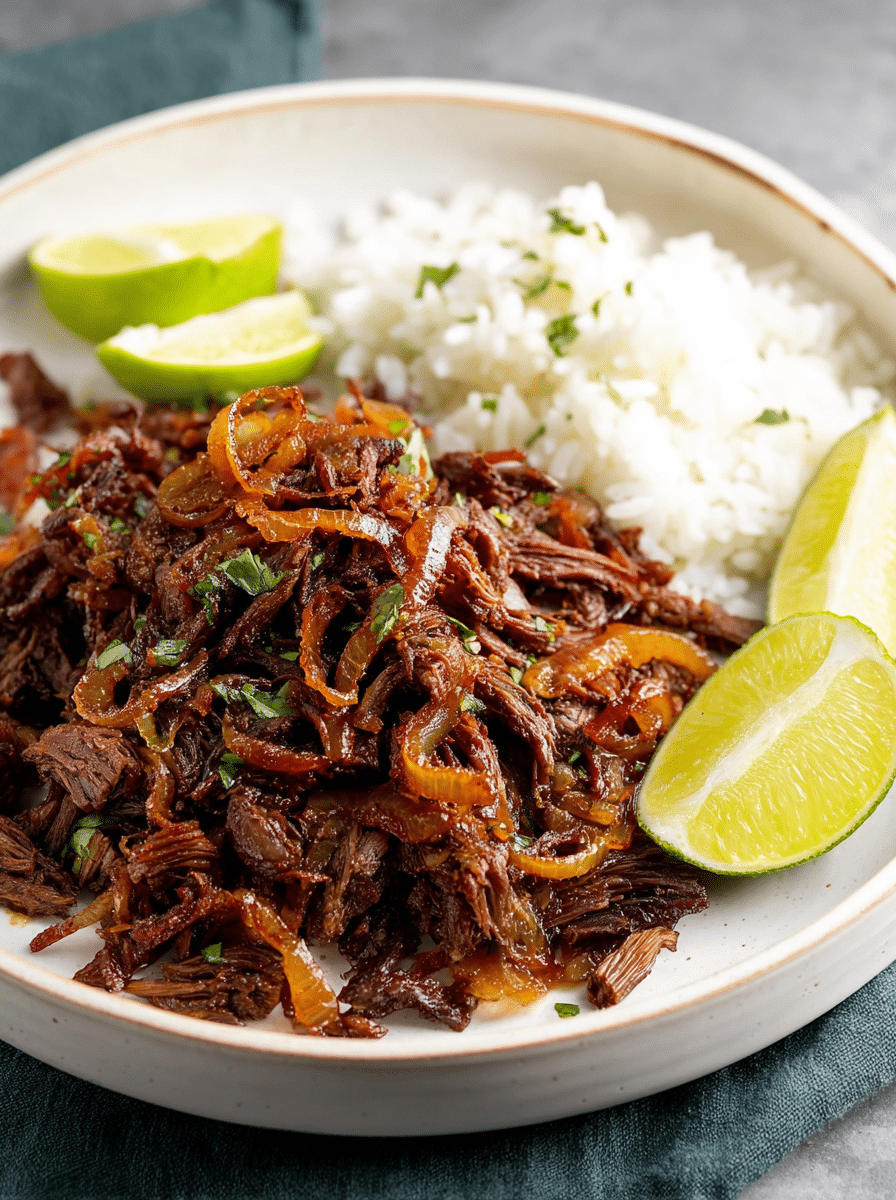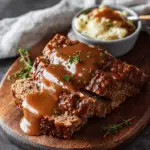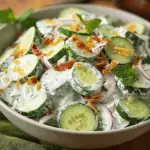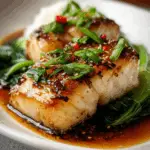Vaca Frita, translating to “fried cow,” is a beloved Cuban dish known for its tender, marinated beef that’s pan fried to achieve a crispy exterior. The process involves boiling flank steak until tender, shredding it, marinating with garlic, lime, and spices, then frying until crispy. It’s often served with white rice, black beans, and lime wedges, embodying the vibrant flavors of Cuban cuisine.
Ingredients
-
2 lbs flank steak (or chuck roast)
-
2 bay leaves
-
1 teaspoon salt
-
¼ cup fresh lime juice (from about 2 limes)
-
6 tablespoons neutral oil (e.g., canola or vegetable oil), divided
-
4 cloves garlic, finely minced
-
1 tablespoon complete seasoning (a blend of oregano, cumin, garlic, onion, salt, and black pepper)
-
Salt and pepper to taste
-
1 medium white onion, thinly sliced
-
Lime wedges, for serving
Directions
-
Soften the Meat: In a Dutch oven or large pot, add the flank steak, bay leaves, salt, and enough water to cover the meat. Bring to a boil, then reduce heat and simmer on medium low until the meat is tender, about 1 to 1½ hours. If using a pressure cooker, cook for about 30–40 minutes. Strain and save the beef broth for another recipe.
-
Shred the Meat: Transfer the cooked flank steak to a platter. Using two forks or your fingers, shred the meat until it has a pulled, shredded texture.
-
Marinate the Meat: In a large bowl, combine the shredded meat with fresh lime juice, 2 tablespoons of oil, minced garlic, complete seasoning, and salt and pepper to taste. Gently toss to coat and marinate at room temperature for 30 minutes.
-
Pan Fry the Meat: In a large skillet, heat the remaining oil over medium heat. Remove the meat from the marinade (discard the marinade) and add the shredded beef to the skillet in an even layer. Cook in batches to avoid crowding the pan. Pan-fry for about 5 minutes without stirring, pressing down with a spatula until the meat is crispy. Flip and cook the other side for another 4 minutes, pressing down again, until the meat is sizzling and crisp.
-
Sauté the Onions: Reduce heat to medium-low. Stir in the sliced onions and sauté with the meat until the onions have softened, about 4–5 minutes.
-
Serve: Serve the vaca frita with lime wedges on the side.
Nutritional Information (per serving)
-
Calories: Approximately 344 kcal
-
Protein: 33 g
-
Carbohydrates: 3 g
-
Fat: 22 g
-
Saturated Fat: 4 g
-
Polyunsaturated Fat: 4 g
-
Monounsaturated Fat: 12 g
-
Trans Fat: 1 g
-
Cholesterol: 91 mg
-
Sodium: 589 mg
-
Potassium: 562 mg
-
Fiber: 1 g
-
Sugar: 1 g
-
Vitamin A: 8 IU
-
Vitamin C: 5 mg
-
Calcium: 42 mg
-
Iron: 2 mg
History and Cultural Significance of Vaca Frita
The origins of Vaca Frita can be traced back to the heart of Cuban cuisine, a fusion of African, Spanish, and indigenous influences. Cuban food is known for its robust flavors, rich textures, and vibrant use of ingredients like citrus, garlic, and herbs. Vaca Frita is no exception—it brings together the Spanish tradition of marinated meats and the influence of African cooking, where slow-cooked, tender meat is often shredded and fried for a crispy finish.
Although the exact origins of Vaca Frita are unclear, it is believed to have evolved from various Cuban dishes that feature marinated beef. The dish is often enjoyed on special occasions or served as a comforting, everyday meal in Cuban households. Its popularity has also spread beyond Cuba, making its way to various Latin American communities and even into global kitchens, where it’s appreciated for its simplicity and bold flavors.
Flavor Profile and Cooking Techniques
One of the most distinguishing features of Vaca Frita is its layered flavor profile. The key to this dish lies in its preparation method. First, the flank steak is simmered to achieve tenderness, which allows the meat to soak in the rich flavors of garlic, lime, and a blend of spices. The marinade, typically consisting of lime juice, garlic, and a special seasoning mix, infuses the meat with aromatic flavors that permeate every bite.
The next step in the preparation process involves pan-frying the shredded meat until it becomes crispy and golden brown. This frying process not only creates a satisfying crunch but also helps caramelize the natural sugars in the beef, deepening its savory flavor. The crispy exterior contrasts perfectly with the juicy, tender interior, making each bite a delight. The final touch is the addition of sautéed onions, which add sweetness and balance to the dish.
The Role of Lime and Garlic in Cuban Cuisine
Lime and garlic play a vital role in the flavors of Cuban cuisine, and Vaca Frita is no exception. The zesty acidity of fresh lime juice helps to tenderize the meat, while also providing a refreshing contrast to the richness of the beef. Garlic, on the other hand, adds depth and a savory aroma that complements the natural umami of the meat.
Cuban cooking often pairs garlic and lime in a variety of dishes, from marinades to sauces, due to their ability to enhance and balance flavors. The combination of garlic’s pungency and lime’s brightness brings a sense of freshness and vibrancy to dishes that might otherwise be heavy or one-dimensional.
The Importance of the Marinade
The marinade is crucial to achieving the authentic flavor of Vaca Frita. It not only infuses the beef with flavor but also serves to tenderize the meat. The lime juice, along with the seasoning blend, helps break down the fibers in the flank steak, making it easier to shred once it’s cooked. The minced garlic adds a pungent, aromatic quality, while the complete seasoning blend of oregano, cumin, garlic, onion, and black pepper provides a savory base.
Marinating the beef for at least 30 minutes allows the flavors to penetrate the meat, creating a more complex and flavorful dish. While many cooks prefer to marinate the beef at room temperature for a short period, some may choose to refrigerate it for longer, intensifying the flavors even further. Regardless of the marinating time, the key is to ensure the beef is well-coated in the marinade, allowing it to absorb all the spices and citrus before it’s fried.
Choosing the Right Cut of Meat
Flank steak is the traditional cut used in Vaca Frita, though other cuts like chuck roast can also work well. Flank steak is favored because it has a rich, beefy flavor and a relatively low fat content, making it a great choice for shredding. The texture of flank steak is perfect for this dish, as it easily pulls apart into thin, juicy strands that absorb the marinade beautifully.
If you decide to use a different cut of meat, such as chuck roast, keep in mind that it may require a longer cooking time to achieve the same level of tenderness. The goal is to choose a cut that will hold up to the marinating process and shred easily once cooked.
Pairing Vaca Frita with Sides
Vaca Frita is often served with traditional Cuban sides, which help balance out the richness of the meat. White rice and black beans are a classic accompaniment, providing a hearty base that complements the savory, crispy beef. The beans, typically seasoned with garlic and herbs, add protein and fiber to the meal, while the rice soaks up the juices from the meat, enhancing the overall flavor.
To add a refreshing element, many Cuban dishes, including Vaca Frita, are served with lime wedges on the side. The acidity of the lime helps cut through the richness of the beef and provides an extra burst of freshness that enhances the overall flavor profile. Some people also enjoy adding a side of fried plantains, which offer a sweet contrast to the savory meat.
Health Considerations
While Vaca Frita is undeniably delicious, it is a rich, hearty dish that should be enjoyed in moderation. The beef provides a good source of protein, which is essential for muscle growth and repair, but it can also be high in fat, especially if cooked with oil. To make the dish slightly lighter, you can reduce the amount of oil used for frying or opt for a healthier cooking method, such as grilling or broiling the meat instead of frying.
The combination of beef and sautéed onions also provides essential vitamins and minerals, including vitamin C, iron, and potassium. The addition of lime not only brightens the flavor but also offers a boost of vitamin C, an important nutrient that supports the immune system.
Variations of Vaca Frita
Although the traditional version of Vaca Frita is made with flank steak, there are several variations of this dish that incorporate different cuts of meat or even other proteins. For instance, some cooks use skirt steak or sirloin for a slightly different texture, while others may opt for chicken or pork. The key to maintaining the essence of Vaca Frita is to ensure the meat is marinated and fried to crispy perfection, no matter the cut or protein choice.
In some regions, Vaca Frita is served with a variety of garnishes, such as sliced avocado, to add creaminess and balance out the dish’s savory elements. You can also experiment with different seasoning blends or marinades, such as adding a touch of orange juice or using smoked paprika for a slightly smoky flavor.
Conclusion
Vaca Frita is a quintessential Cuban dish that beautifully showcases the bold and complex flavors of the island’s cuisine. Its combination of tender, marinated beef, crispy texture, and aromatic spices creates a dish that’s both comforting and exciting. Whether you’re making it for a special occasion or a casual family dinner, Vaca Frita is sure to impress with its vibrant flavors and satisfying texture.
By understanding the key elements of Vaca Frita—the marinade, the frying process, and the perfect balance of flavors—you can bring a piece of Cuba to your table and share this beloved dish with family and friends. Whether enjoyed on its own or paired with traditional sides like rice and beans, Vaca Frita is a celebration of the rich culinary heritage of Cuba, offering a delicious, flavorful experience that’s hard to forget.





